
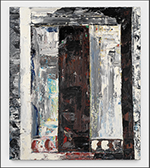

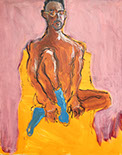

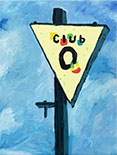

William Corwin: “Lethe-Wards”
at Geary Contemporary, Millerton, NY
by D. Dominick Lombardi
Visiting an art gallery in a small town will always end with varying results, especially when you’re looking for challenging contemporary art. When you find an exhibition in such circumstances that prompts you to think and expand your aesthetic experience, the rewards are well worth the effort it takes to get there. Millerton, NY, a small upstate town, stands in the midst of corn fields, grain silos, and slow-moving farm equipment. Its population is well under 1,000. This is the setting of Geary Contemporary, which offers a diverse roster of exhibitions and artists, some with studios in New York City. Currently, William Corwin’s installation “Lethe-Wards” fills the sun-drenched storefront space with a number of cast iron objects, most of them presented on a low-level platform that braces two sheets of four-by-eight-foot plywood with eight, short, brown saw horses. Added to the mix are a few small shelves and pedestals here and there that very nicely round off the space. The exhibition's title, “Lethe-Wards,” refers to John Keats’s "Ode on Melancholy," which alludes to the Greek myth that, if you drank from the waters of the river Lethe, you would be free from all memory of your past. With Corwin’s work, there is the distinct feeling that those collective recollections of the past can begin to be restored within the forms of ancient boats, seen here as small-scale sculptural symbols. And as symbols, they revive that long past desire to discover, and the ingenuity to achieve such things by traveling great distances across seas and along rivers.
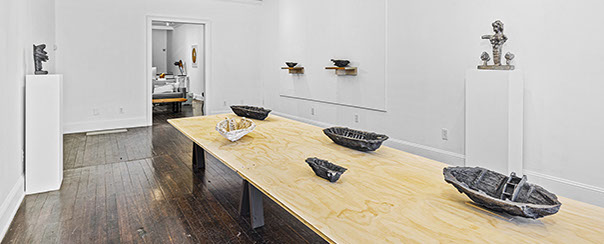
William Corwin, "Lethe-Wards," installation view. Image courtesy of the artist and the gallery.
Most of the boat sculptures, several cast iron and one plaster, are “inspired by ancient burial boats used in Egyptian, Anglo-Saxon, and Mapuche societies,” says the artist. My first thought in seeing these works, though, was of the long-lost Pre-Columbian boats rediscovered in various locations in the Americas, both on the Pacific and Atlantic coasts. For me, these boat sculptures fully transmitted the artist’s intention of inspiring thought about the rigors, risks, and rewards of some of the earliest modes of distant travel.
Adding layers to the narrative of travel, change, and discovery in these sculptures is the inclusion of ladders (another symbol of transition) and text such as HAD SUNK. What I find most impressive is the fact that Corwin collaborates with the Rivers of Steel at The Carrie Furnaces in Pittsburgh, where he uses repurposed iron donated by the DMV of Pennsylvania to create his sculptures. Corwin’s process—one half of the free-formed molds for the bottom and another for the corresponding top—is done quickly and instinctively by hand, with no preliminary sketches. When placed together, these two newly formed molds create an encasement for the proposed positive object, which is formed in turn by the pour-in of the liquid iron. This primitive type of mold-making leaves distinct marks of the artist’s process in the form of finger impressions. The molds’ organic looking roughness is very pleasing to the eye and gives these works their timeless appearance.
To be able to pour iron into these one-off hand-formed molds, Corwin must add channels that enter from above, as well as venting shafts for the resulting off-gasses and hot air. And here is the one minor rub. The artist uses a hacksaw or some such tool to cut off the unwanted or unintended iron buildup from the pouring channels and vents. These clean, somewhat shiny cuts are counterintuitive in color and texture to the intended organic surface and patina of the cast iron, leaving one aspect of the artist’s process in clear view. It’s an element that contradicts the very natural looking dull gray surface of boats. If the material were not too brittle, these areas could be worked somehow to fit in better aesthetically with the rest of the tactile qualities of each piece; however, that may not be possible. On the other hand, the little bits of rust here and there on some of the works, such as Small Charger, Curragh 2 (2021), give the iron life, as if it is still becoming something. With all these details aside, the overall presentation of the boats is quite striking and very memorable.
There are two additional works in the exhibition that relate to the process, texture, and historic references of the boat series, though they are quite different in subject. They are homages, of a sort, to the classic, iconic, mythical goddess Artemis of Ephesus. A second difference is that these three-sided sculptures are an “open face” pour, according to the artist’s terminology, which means a partially shaped mold is used to create the front and sides without an opposing mold to form the back. In addition, the larger of the two sculptures is aluminum and bears a beautifully pitted texture colored by the warm glow from the gallery's lighting. Corwin’s versions of Artemis of Ephesus are similar enough in shape and composition to make a visual connection to their historical referents. At the same time, they have a direct connection to the process involved in Corwin’s boat sculptures, with strong indications of the erosion of time and the unforgiving challenges of structural integrity. Corwin’s methods point to how exposure to the elements leads to the obliteration of detail.
My first thought when seeing Artemis Ephesia (2022) was of Picasso’s more misaligned, mangled cast bronze sculptures and of Giacometti’s portraits or heads—a first impression that dissolved quickly upon closer inspection. Corwin’s interpretation of the goddess Artemis is much more about the economics of process in the way that it simplifies form, and it is reminiscent of Art Brut or CoBrA in its emotional content. The disbandment of details as a result of the techniques used to create the mold leaves behind a loosely haunting, and very penetrating, presentation that clearly commands its allotted space. If we were once meant to look up to such figures as Artemis of Ephesus in the life-sized or even larger versions made by the ancients, Corwin manages to achieve that level of adoration with an object that is barely over a foot and a half tall.
Overall, what we have with this installation of Corwin’s works is a reinvigorated sense of history. His art is a counterpoint to banal passing afterthoughts or waning remnants of cultures salvaged by museums and archeologists that have lost their depth of meaning in today’s digital, meme-defined, politically fueled, and social media–crazed age. Corwin is asking us to remember and investigate, and to ignore the one-sided views of history that we all grew up with; he asks us to take a more global view of the world around us. Some cultures are built on passion and poetry, others on icons of self-serving projections of laws and punishment, and still others on overwhelming domination and fear. Corwin is steering us towards a truth that is substantiated by actual, concrete, physical facts, and the openness to be enlightened.
D. Dominick Lombardi is a visual artist, art writer, and curator. A 45-year retrospective of his art recently traveled to galleries at Murray State University, Kentucky in 2019; to University of Colorado, Colorado Springs in 2021; and the State University of New York at Cortland in 2022.
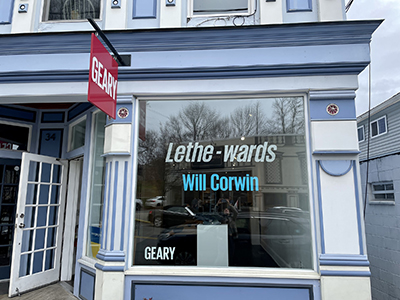
Geary gallery entrance, 2022. Image courtesy of the artist and the gallery.
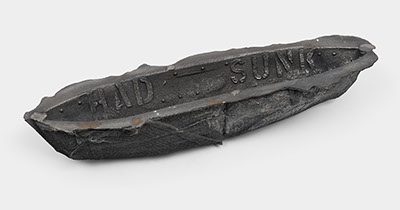
William Corwin, Had Sunk (2022), cast iron, 24 ½ x 8 ¼ x 5 inches. Image courtesy of the artist and the gallery.
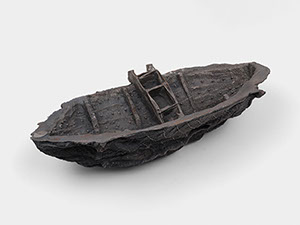
Will Corwin, Small Charger, Curragh 2 (2021), cast iron, 20 x 11 ½ x 5 inches. Image courtesy of the artist and the gallery.
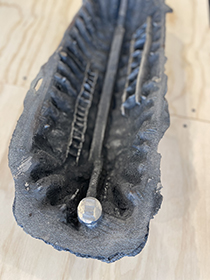
William Corwin, Long Boat, Two Passengers (detail of cut metal) (2022), cast iron, 25 ½ x 10 x 5 inches. Image courtesy of the artist and the gallery.
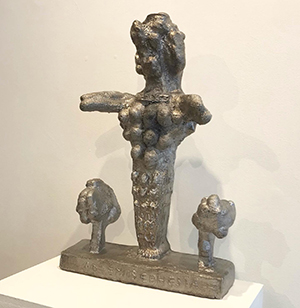
William Corwin, Artemis Ephesia (2022), aluminum, 18 ½ x 12 x 4 ½ inches. Image courtesy of the artist and the gallery.